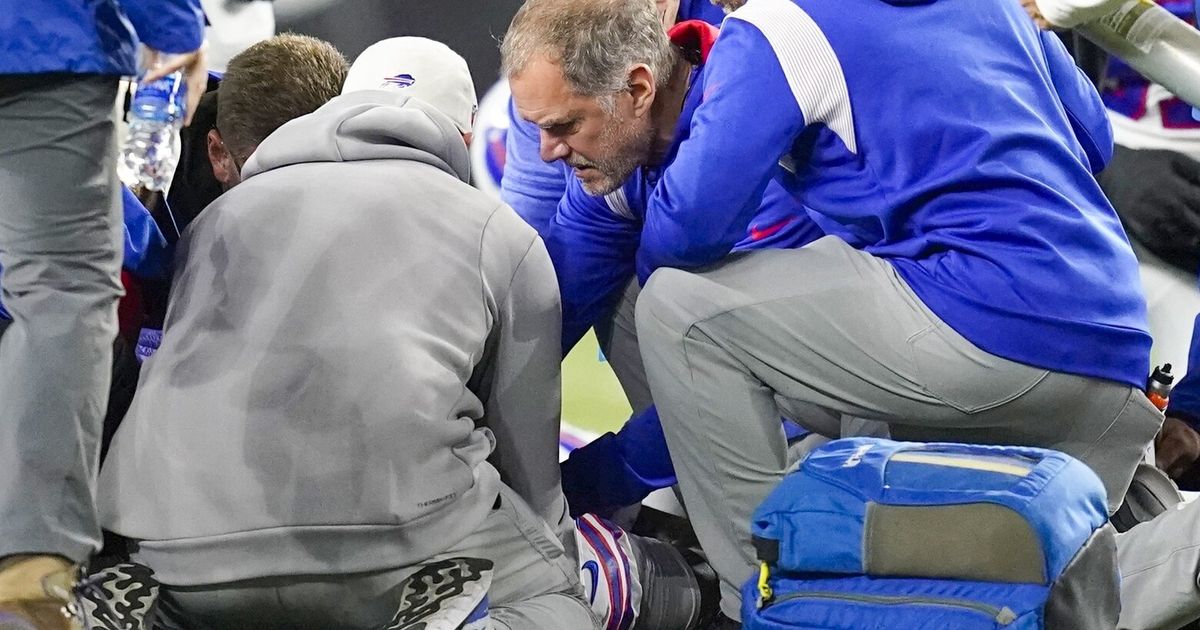
The chilling scene in Cincinnati on Monday when Buffalo Bills safety Damar Hamlin suffered cardiac arrest on the field served as a reminder to local sports medical practitioners of the value in having their emergency plans as updated and practiced as possible.
“It causes you to look back at your own plans and see if there are gaps,” Dr. Kimberly Harmon, the head football physician for the University of Washington Huskies, said in a phone interview Tuesday. “We’ve been doing sudden cardiac arrest (plans) here for decades, and it is certainly front of mind. But there are always things you don’t think about or things you might be able to do better, and it reminds you the importance of it because when you practice year after year and nothing ever happens you may be like, ‘Do we need to do this?’ But it becomes automatic (to execute the plan on the field) if you’ve practiced it and you know what to do.”
In a statement, the Bills said Hamlin suffered cardiac arrest following a hit in the first quarter against the Bengals and that his heartbeat was restored on the field. He was taken to a local medical center where the Bills said he remained in critical condition Tuesday.
According to a tweet from NFL spokesman Brian McCarthy on Tuesday, each team has on average a 30-person gameday medical staff, including a two-person emergency medical technician/paramedic crew.
Harmon said UW has at least four physicians on hand for football games as well as the athletic training staff and a paramedic crew, and that visiting teams also have their own training and medical staffs present. Harmon said the staffs of the two teams meet before every game to review the emergency action plan.
Specific details of all of the actions taken to treat Hamlin on the field have not been revealed. But USA Today reported Tuesday that the NFL confirmed that Hamlin was given CPR and oxygen and that an automated external defibrillator, or AED, was also used on the field before his heartbeat was restored.
It was estimated that Hamlin was treated on the field for around 15 minutes before being transported.
Being able to work quickly in such situations is particularly important, which is why Harmon and the rest of the UW medical staff practice annually all of the situations that could arise during a football game.
The practices include members of the Seattle Fire Department and simulate as many potential emergencies as possible, such as how to properly treat and board someone in case of cardiac events or spinal injuries.
“When we do our annual practices, we have someone that is in pads, and we have them fall down in different positions so that we can practice rolling them in different positions,” Harmon said.
Such practices are conducted for all sports teams on campus and at all the different venues to go over such things as the best routes for leaving the area and getting to a hospital, Harmon said.
Whenever anyone collapses, as Hamlin did Monday, Harmon said they assume “it’s a cardiac arrest until proven otherwise. … The more rapid you can get somebody CPR and especially a defibrillator, statistically the better the outcome.”
As Harmon noted, speculation has been that Hamlin may have suffered what is called commotio cordis, when blunt trauma to the heart leads to ventricular fibrillation. Or as Harmon described it, it’s “when somebody gets struck in the chest at precisely the right point in the electrical cycles, and it causes it not to work anymore so the heart stops.”
“Unrecognized cardiac arrest can be really dangerous, so that’s why you just really need to assume when an athlete goes down, after you have taken care of the spine or are paying attention to it, especially in a contact sport like football that that (cardiac arrest) is something you think about.”
Harmon said part of the review before every game is to make sure AEDs are easily accessible and fully charged.
“You need know where the AED is and that there’s a plan to keep them charged and operational and that know how you are going to call 911 and how emergency responders are going to find you and where they meet,” Harmon said.
“The tragedies you hear about in middle school and high school are often like when the AED is locked in the nurse’s office, so there is an AED there, but it is inaccessible, or someone has forgotten to charge it. So just having a plan to make sure all of your I’s are dotted and T’s are crossed is important.”